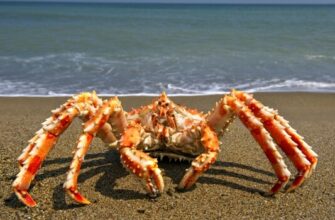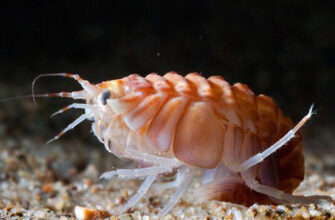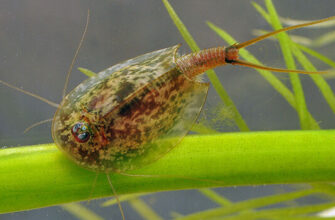What does an alpaca look like and how is it different from a llama? Alpaca (emphasis is placed on the last syllable) — an animal one meter high with a long neck from the camel family. Domesticated by local Indians, more than two thousand years ago in South America, namely in the highlands. The species of this animal, for its most valuable fur in the world, is bred more and more, especially in Australia, where the climate is suitable for them.
Origin of the species and description
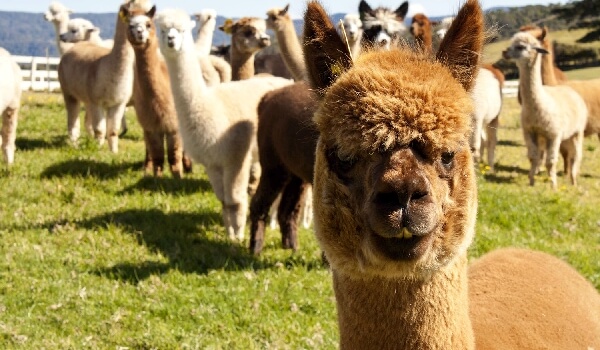
Photo: Alpacas
To study this animal and its habits, scientists spent years examining the animal’s DNA and proved the veracity of the hypothesis:
- they belong to mammals;
- a detachment of artiodactyls;
- suborder callosophages;
- camelidae;
- genus vicuña.
There are several species of these animals in the world, similar in appearance to each other. The first are the largest llamas, the guanacos are miniature and shorter, and the vicuñas, which outwardly differ in their smaller size and grace, and the shaggyest are the alpaca. These animals have existed since ancient times, but outwardly they have not changed. The weight of an adult reaches up to 70 kilograms, and they grow up to one meter in height.
Video: Alpaca
In South American countries, alpaca are bred in natural conditions, on pastures. So, according to the locals, their life expectancy is much longer, and they gain weight faster. They were brought to Europe about 20 years ago, with the aim of growing them as a decorative pet. Although this species is not entirely affordable, however, those who allow themselves this “luxury” note that a pet with a friendly disposition is conducive to itself and “communication” with it is used in medicine.
There are two breeds of alpaca: Huacaya and Suri. Wool is the hallmark.
- Suri’s wool hangs in pigtails to the very ground and is distinguished by its special softness and grace. This is the most valuable and rare type of alpaca.
- Huacaya, due to its dense and even coat, is precisely the real alpaca species. They are grown for raw materials that are much easier to process than Suri.
Appearance and features
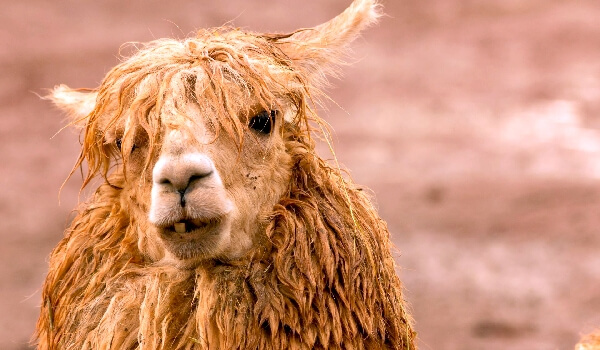
Photo: Alpaca Animal
Due to the lack of hooves, they are assigned to the callus-footed suborder. This corn growth replaces their foot and hoof. They have two-toed limbs with blunt, curved claws. In the wild, the claws are worn against the stones and the roughness of the rocky plains, and if the pet is kept in a paddock, then the claws need to be cut periodically. When walking, they rest on the phalanges of the fingers, as a result of which pastures are not trampled. In paddocks, they need soft flooring in the form of straw.
They tear off vegetation with their lips and chew food with the help of lateral incisors, as there are no upper teeth. With age, the incisors are erased and gradually grow back. Having thick fur, they feel great in mountains with a height of 3 thousand meters, and are also able to breathe high-mountain air with a low oxygen density. The body of a ruminant animal is adapted to process a large amount of vegetation. During the whole day they collect food in their unusual stomach with three compartments (the rest of the ruminants have four), and in the evening they process it.
Among the ancient Indians, alpaca wool was considered an exchange currency, and manure was considered a valuable and excellent fuel. The skin was used to make clothes. Alpaca meat is eaten, but extremely rarely. They will be more useful in a living form.
Currently, wool is considered the highest quality and most expensive. For the manufacture of designer items with maximum brilliance and softness, young alpaca cloth is used. And for carpets and outerwear, the wool of older individuals is ideal.
Where does the alpaca live?
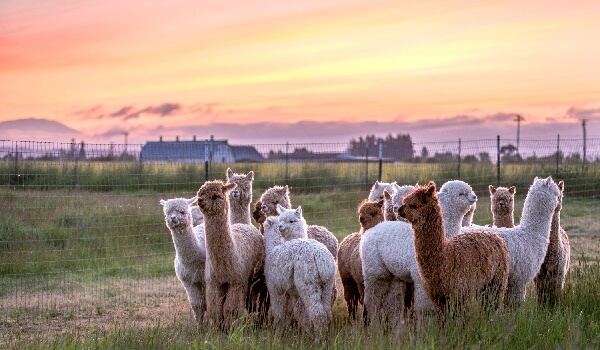
Photo: Funny alpacas
These animals live mainly in the southern — American Andes in the Altiplano (plateau, the second largest) and in the countries of the Peruvian Highlands, graze in Ecuador, Argentina. Where the climate is harsh and changeable, you can meet a herd. On the snowy border of the mountains, where the vegetation is rather sparse, but it is the moss swamps that attract the inhabitants of the Peruvian fauna there.
In Chile and Argentina, there are semi-wild herds that are caught from time to time to collect wool. In other countries, as in Africa, in the natural environment, they do not survive as well as their usual habitat is the high plains. And too hot weather is not conducive to fruitful breeding. In England and New Zealand, they are domesticated and kept in special pens.
There are several zoo farms in Russia, but growing alpaca is a whole skill. They are equipped with a canopy from rain and snow. They do not need a warm room, but they need to be protected from the wind.
What does an alpaca eat?
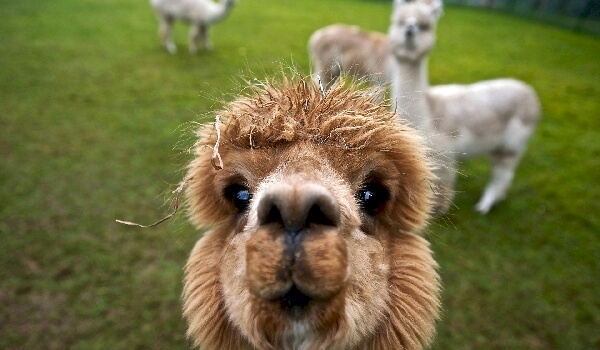
Photo: Alpaca
In the natural environment, they are not whimsical in food and use young shoots, moss and herbaceous succulent plants, and even thorns to quickly grind food. And if you keep an animal in a corral, then you must definitely give food similar to that which grows in their natural habitat. Alternate hard, weed-free hay with rich, mineral-rich grass. So how the soil is different from South American lands. Be sure to indulge in vegetables and fruits. If desired, give stale black bread.
Well, if the herd is grazing in the meadows, then the farmers plant nutritious plants such as alfalfa and clover on the pastures. Required unlimited drinking and the presence of salt licks, to prevent harmful microorganisms and for good digestion. Lactating females need protein supplements.
If you plan a paddock, then you need to know that they gnaw trees and shrubs. Therefore, the fence should be built away from lilac bushes, which can harm animals. Well, save fruit trees, the main delicacy. The quality of wool is influenced by a combination of natural conditions and food consumed. In the “homeland”, in the Andes, grass grows – itchu, the only food for Peruvian alpacas. Therefore, Peru has the most valuable species of these animals.
Peculiarities of character and lifestyle
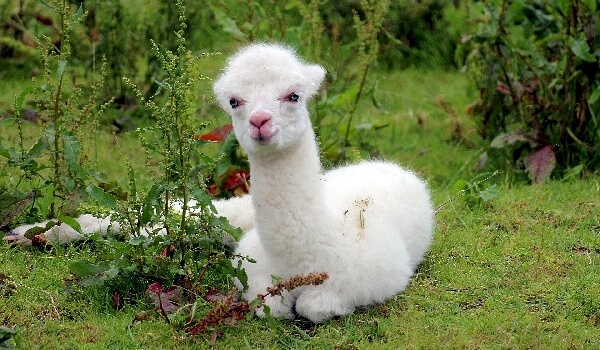
Photo: Cute alpaca
Clean animals with the kindest eyes. In the countries of Argentina, you can meet a child playing with a cub or an adult. A non-aggressive creature is kind to a person. If you beat off one animal from the herd, then it instantly falls to the ground and does not get up. In this position, farmers usually carry out a haircut.
Pregnant females show aggression towards annoying owners. They can pinch or spit.
Alpaca gets along well with livestock. Cattle breeders were convinced more than once of the ability to graze sheep, preserving the herd. Walking on the lawn, they carefully pluck the dry grass, rid the meadows of thorns. The sounds they give out are similar to a musical trill. With this sound they show their interest, anxiety or danger.
Social structure and reproduction
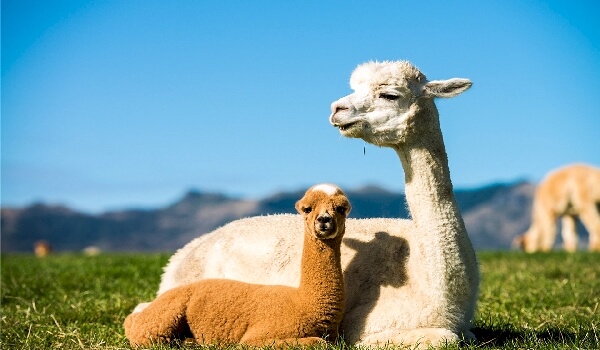
Photo: Baby Alpaca with Mom
By crossing alpacas and llamas, domestic offspring are obtained – Uarisos. But the offspring itself can no longer reproduce. Lamas, alpacas, guanacos easily interbreed. Puberty in females begins from 18-24 months, and in males from 24-30 months. They are ready for full mating and fertility after two years.
The mating season is year-round. Reproduction in the wild is “controlled” by the male himself, not letting in “strangers”. And if two — three herds united, fierce battles are fought on the pastures for the rights of superiority, and each leader makes sure that mating is not carried out with other males. And in captivity, a person exercises control and selects the most promising and prolific males. You can determine the fertilization of a female by her behavior. Usually she is ready to mate even after giving birth, but if she is already pregnant, then she does not let the male approach her even a single step.
Females are not particularly hardy during pregnancy and miscarriages often occur. They carry the fetus for eleven months. If the cub was lucky enough to survive, then they are born with a weight of 1 kilogram and after an hour they already stand up on their own. It grows actively and by 9 months reaches 35-40 kilograms. Mostly one cub each, in a rare case two, which subsequently both die. At the time of birth, the herd is nearby, at the level of natural instinct, they are obliged to guard the female and the giving birth to the alpaca.
Natural enemies of the alpaca
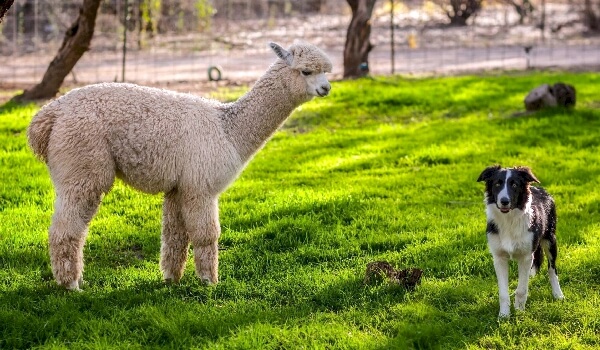
Photo: Alpaca and dog 🙂
In the wild, cougars, jaguars, and coyotes are enemies. Cougars and leopards live in those areas, and if the individual is large, then the herd will not be able to fight back, having lost one of its relatives. Perhaps the cougar is the only predator that climbs high into the mountains. But in pursuit of the alpaca, it quickly gets tired, which gives an advantage to the whole herd.
They resist small predators by kicking with their front legs. They perfectly feel the predator at a distance and with a loud roar they warn of an approaching danger. This very roar, which picks up the whole herd, is very piercing and scares away predators. Fast running saves from maned wolves — loners and foxes. For defense, spitting is used, which is also effective against predators. Spitting is also applicable within the herd in the struggle for food.
Population and species status
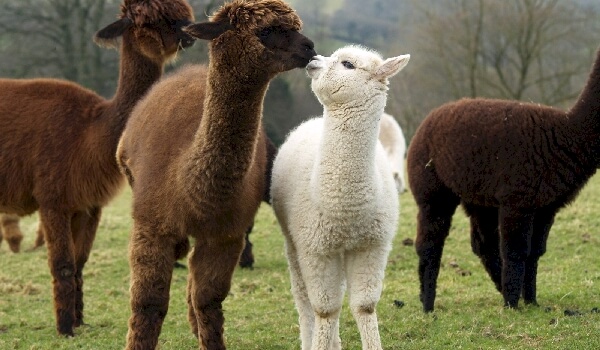
Photo: Alpacas
There are estimated to be 3.5-4.5 million alpacas. Animal population formed 2.5 million years ago. Guanacos and vicuñas have always kept aloof, growing wild, and llamas and alpacas became domesticated about 5-6 thousand years ago. The alpaca population has long declined, since the time of the discoverers on the lands in South America and in the wild, they can no longer be found without human supervision. The colonists, for breeding their livestock, “expelled” the herds to the less passable places of the Andes, this significantly reduced the livestock. But they had to adapt to the highlands and look for areas with horizontal pastures. After all, they can’t climb mountains. External signs between an alpaca and a llama can be confusing.
But there are differences between these little animals:
- Lama ears are long and lowered to the muzzle, similar to a crescent moon. And in alpaca they are pointed;
- the shape and size of the muzzle of the alpaca is round and small. In the llama, it is elongated and narrow;
- the weight of the llama is much more, twice;
- llamas are shy loners in life, the hospitable alpaca has a herd feeling;
- the wool of the former is coarser, while that of llamas.
These animals also differ in temperament and behavior. Alpacas are less aggressive and llamas may kick or spit for no reason. The British industry, in search of natural products, introduced raw materials made from wool to the textile market. Thus, this species of animals came out of the shadows and again began to be revered by the population. Hunting for this species, as well as for vicuñas, was banned.
Conservationists argue that the alpaca population is not threatened, and there is no urgent need to list them in the Red Book. But, however, in Peru there is control over the export and slaughter of animals.
It is worth mentioning the properties of alpaca fiber. They come in 16 to 18 colors. From white to gray with a pinkish tint, from yellow to dark — brown. You can find black colors, but everything is in demand, but the white tone is the most scarce. In the textile industry, there is no need to dye wool, it is used in its natural form.
Alpaca fleece is characterized by the following properties:
- moisture-proof and water-repellent;
- light weight with a soft texture;
- warmer than sheep’s wool;
- the product does not prick and does not cause allergies;
- durable and does not get dirty for a long time, thanks to the absence of lanolin.
Alpaca produces the highest quality wool and distinguishes it qualitatively from most other natural fabrics. You won’t find more durable and comfortable clothing.


